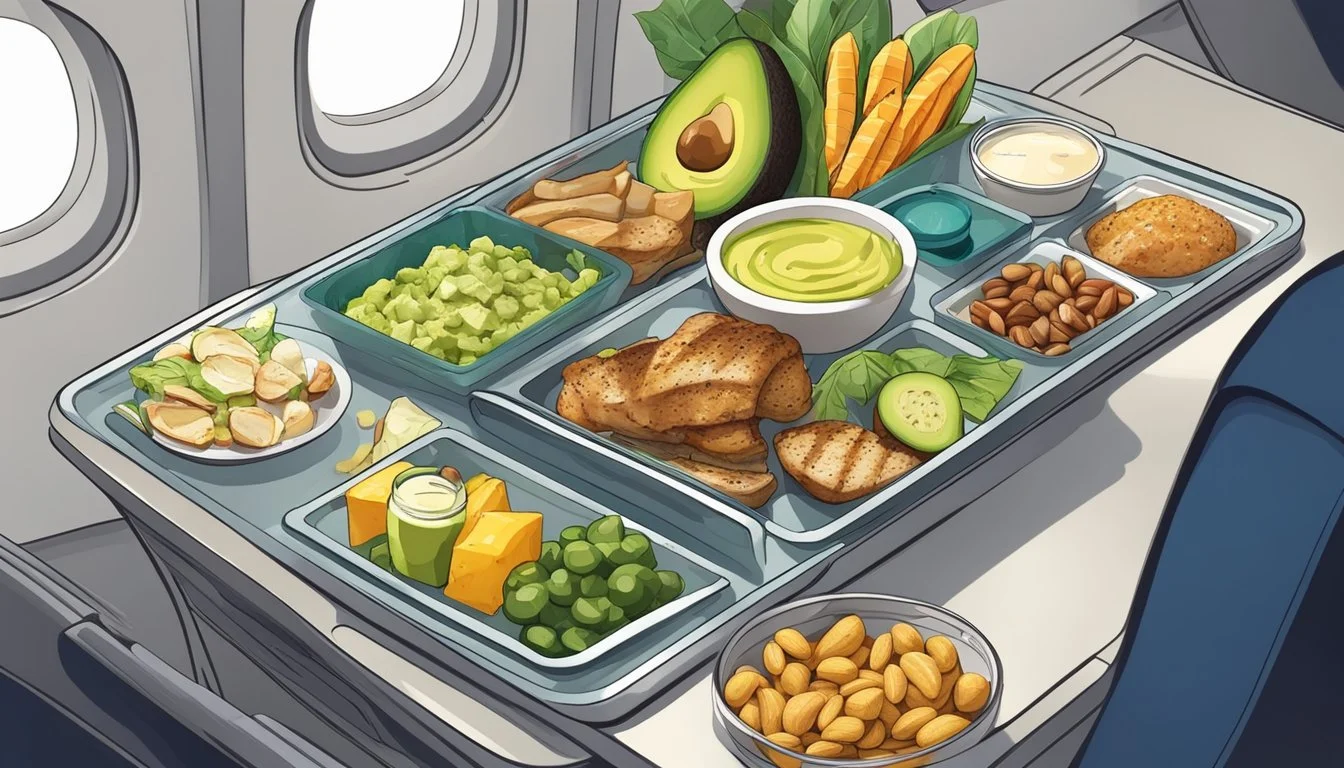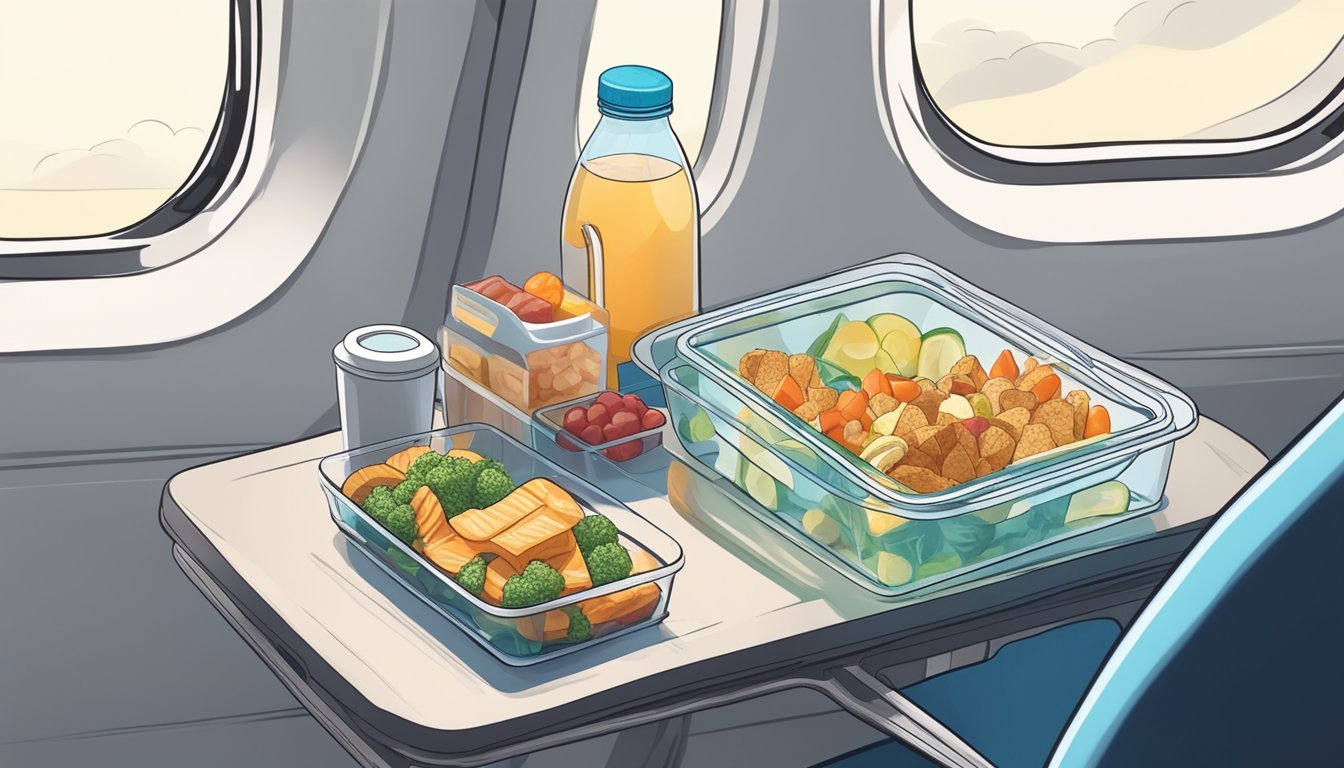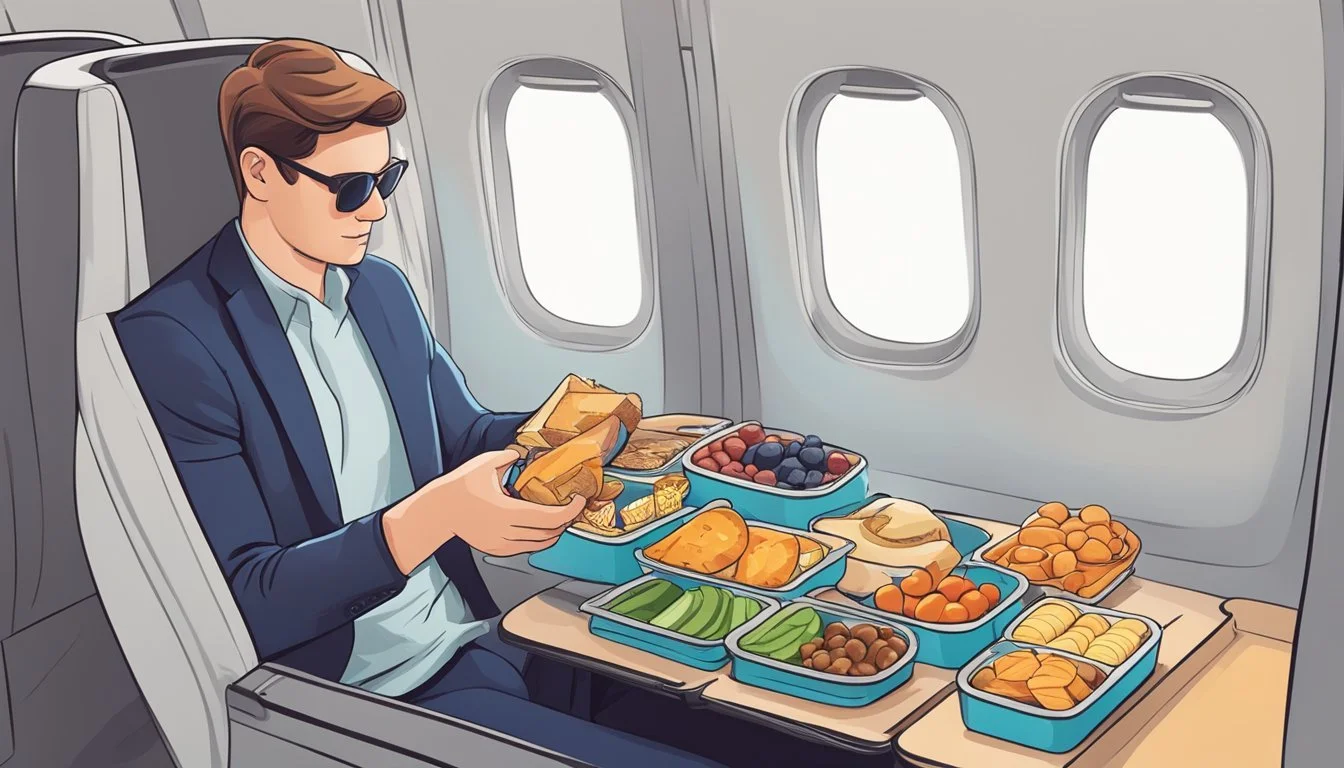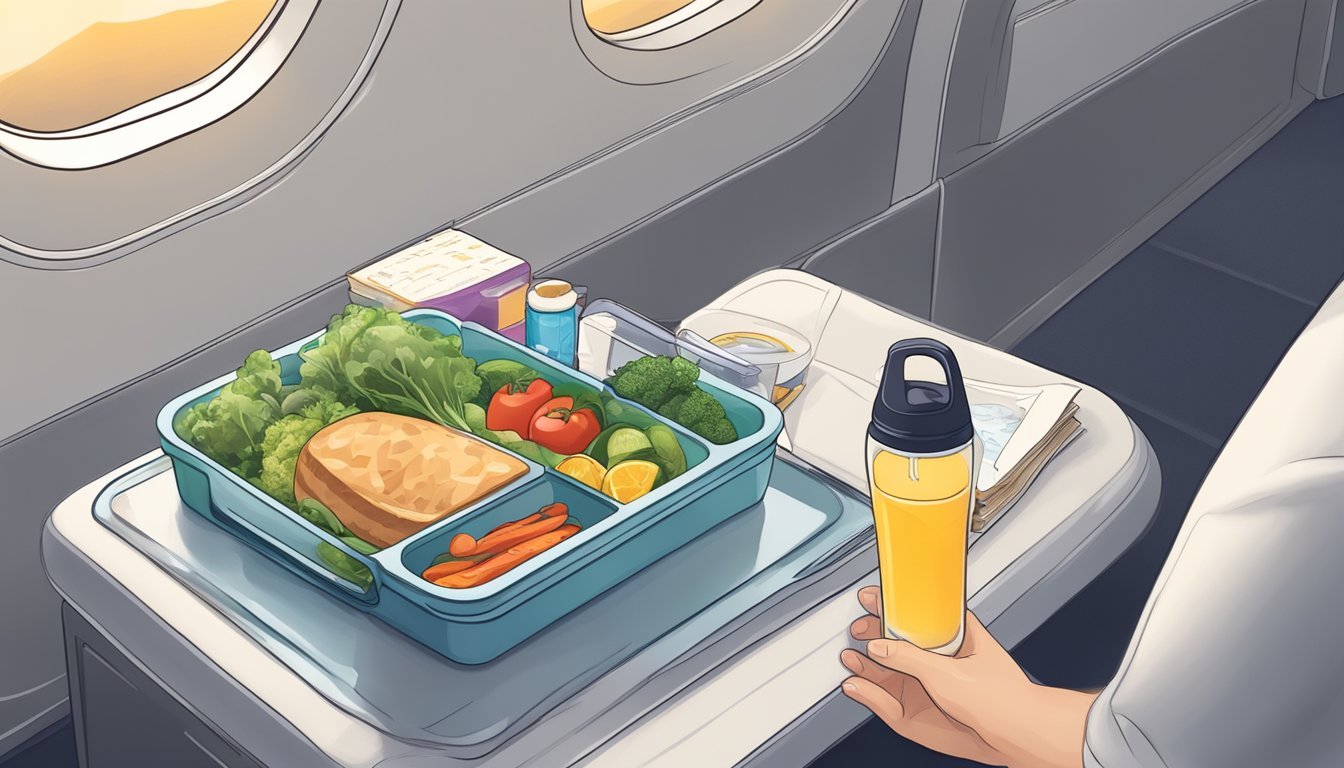Keto Diet on a Plane
Tips for Staying Low-Carb at 30,000 Feet
Maintaining a ketogenic diet while traveling, especially during flights, can present unique challenges. The ketogenic diet, which focuses on high-fat, moderate-protein, and low-carbohydrate intake, requires careful planning and smart choices to stay on track. Airline cuisine is typically rich in carbohydrates and limited in keto-friendly options, necessitating forethought and self-sufficiency for adherents of the diet.
To successfully adhere to a keto regimen on a plane, passengers often bring their own snacks (What wine goes well with snacks?) and mini-meals to avoid the common carb-heavy options provided by airlines. Portable and non-perishable food items like nuts (What wine goes well with nuts?), seeds, and hard-boiled eggs are popular choices that are also compliant with transportation security guidelines. These foods provide the necessary macronutrients that align with the stringent requirements of the ketogenic lifestyle.
Travelers following the keto diet are encouraged to prepare for their journey by packing appropriate snacks and researching meal options. This practice not only helps in maintaining dietary consistency but also ensures satisfying and stress-free travel. Staying keto on a plane is achievable with preparation, allowing travelers to enjoy their trip without compromising their dietary goals.
Understanding the Keto Diet
The ketogenic diet is a meticulously planned way of eating that emphasizes high fat, moderate protein, and very low carbohydrate intake. Its primary aim is to shift the body's metabolism towards fat burning by entering a state called ketosis.
Principles of Ketosis
Ketosis is a metabolic state where the body uses fat for fuel instead of carbs. Normally, carbohydrates in food are converted to glucose, which is the body's preferred source of energy. When carbohydrate intake is severely reduced, the body begins to break down fats, producing ketone bodies. These serve as an alternative energy source for various organs, especially the brain. This shift from glucose to ketones is the cornerstone of the ketogenic diet.
Macronutrient Ratios
A typical ketogenic diet substantially alters traditional macronutrient ratios. To achieve ketosis, the diet prescribes consuming:
70-80% fats
10-20% protein
5-10% net carbs
For most individuals, maintaining less than 20 to 50 grams of net carbs per day is crucial for staying in ketosis. Net carbs are calculated by subtracting fiber and sugar alcohols from total carbs, providing a more accurate reflection of carbohydrates that affect blood sugar levels.
Food to Enjoy and Avoid
On a ketogenic diet, certain foods should be emphasized, while others are limited. Here is a concise list:
Fats: Avocado, olive oil, coconut oil, butter, and ghee
Protein: Meat, poultry, fish, and eggs
Low-carb Vegetables: Leafy greens, broccoli, cauliflower
High-carb Foods: Grains, starches, sugars, and fruits
Processed Foods: Those high in sugar and low in nutritional value
It's essential for individuals to select high-quality, nutrient-dense foods to ensure nutritional needs are met while maintaining the strict macronutrient ratios necessary for the diet.
Preparing for Your Flight
When embarking on a journey, those following a ketogenic diet need to strategically plan meals and snacks to stay in ketosis. Maintaining proper hydration and avoiding keto flu during the flight are also critical for a comfortable travel experience.
Keto Meal Planning
One should choose in-flight meals that align with the high-fat, moderate-protein, and low-carbohydrate ketogenic diet. It's advisable to contact the airline ahead of time to request a special meal if available or opt for bringing homemade keto meals which can include:
Grilled chicken or fish
Leafy salads with olive oil dressing
Steamed vegetables with butter
Packing Keto Snacks
Travelers should pack a variety of keto-friendly snacks to prevent carb cravings and hunger pangs during the flight. Ideal snacks include:
Nuts and seeds: Almonds, macadamias, and pumpkin seeds
Fat bombs: Coconut oil or butter-based for a quick energy boost
Olives and jerky: Salty and satisfying, these snacks can help maintain electrolyte levels
Hard-boiled eggs and cheese: Convenient sources of protein and fats
Low-sugar fruits: Avocado slices or berries in moderation
Protein bars: Ensure they are low in net carbohydrates
Hydration Tips
Staying hydrated is essential, especially in the dehydrating environment of an airplane cabin. Travelers should aim to:
Drink plenty of water before, during, and after the flight
Avoid diuretics like caffeine and alcohol which can increase dehydration
Avoiding Keto Flu in the Air
To prevent symptoms of keto flu — a side effect of entering ketosis that can feel similar to flu — while in the air, passengers should focus on:
Adequate intake of electrolytes through supplements or by adding a pinch of salt to water
Consuming sufficient fats to maintain energy levels without the need for carbohydrates
With careful meal planning, proper snack packing, intentional hydration, and strategies to combat keto flu, individuals can successfully navigate their keto diet while flying.
Keto-Friendly On-Board Options
Maintaining a ketogenic diet while flying can be managed with strategic choices from the in-flight menu, a careful selection of beverages, and understanding the variations in service across different flight classes.
Navigating the In-Flight Menu
When examining the menu, passengers should look for options that emphasize fats and proteins while minimizing carbohydrates. Typical menu items suitable for a ketogenic diet may include cheese platters or salads with olive oil dressings. Passengers should avoid items with bread, pasta, or sweet dressings. Some airlines may also offer specific keto-friendly snacks, like nuts or cheese cubes, which fit the macronutrient requirements of a keto diet.
Selecting Keto Beverages
For hydration, water remains the best choice. Coffee and tea are also keto-friendly, but passengers should avoid adding sugar or milk in large quantities. For those who prefer to consume alcoholic beverages, options like spirits served neat or with water or club soda, like vodka or tequila, are generally low in carbs. However, passengers should consume alcohol in moderation to maintain their diet and stay hydrated.
Keto Options in Different Classes
The range of keto-friendly options can vary widely depending on the class of service. Business and first-class passengers often have access to a more extensive menu that can include higher-quality proteins, like smoked salmon or grilled chicken, and more elaborate salads. However, economy class can still provide acceptable choices, such as packs of almonds or small cheese portions. Passengers may request to see the ingredients of meals to ensure they align with their dietary requirements.
For passengers who worry about the availability of keto-appropriate foods, bringing pre-packaged snacks or small containers of nuts, seeds, or cheese can serve as a reliable backup.
Intermittent Fasting and Travel
When it comes to maintaining a ketogenic lifestyle on a plane, intermittent fasting can be a strategic approach. It simplifies meal planning and helps travelers adhere to their dietary regimen.
Combining Keto with Intermittent Fasting
Intermittent fasting involves cycling between periods of eating and fasting, and it can complement a ketogenic diet by enhancing fat-burning and ketosis. Travelers might find it convenient to align fasting windows with flight times, thereby reducing the need to find keto-friendly options at airports or on board. For instance, one might schedule a fast to begin a couple of hours before departure and end upon arrival or at the next mealtime.
Managing Hunger and Cravings
Hunger management is crucial while fasting, especially during travel when stress and boredom can trigger cravings. To alleviate hunger pangs, travelers should:
Stay hydrated; water can help to reduce hunger sensations.
Engage in low-intensity activities like reading or listening to music to keep the mind occupied.
Use mental preparation; knowing what to expect during a fast can empower an individual to resist temptations.
For cravings, it's also helpful to carry keto-friendly snacks (notably non-nut options due to potential flight restrictions on nuts) for consumption during eating windows. These can include:
Seeds: Pumpkin, sunflower
Cheese: Portions of hard cheeses
Vegetables: Sliced cucumbers, bell peppers
By using these strategies, individuals can effectively manage their ketogenic diet while fasting during air travel.
Staying Keto at the Destination
Maintaining a ketogenic diet while traveling requires foresight into dining options and an understanding of how to navigate various cuisines. It's also important to consider the possibilities for preparing your own meals depending on the accommodations.
Finding Keto-Friendly Restaurants
When they arrive at their destination, travelers should seek out restaurants that offer keto-friendly options. This can involve some research beforehand or asking locals upon arrival. Many establishments provide nutritional information online or upon request, which can help in identifying suitable dishes. It's advisable to look for restaurants that emphasize:
Protein sources: meat, poultry, and fatty fish
Low-carb vegetables: leafy greens, broccoli, and cauliflower
Healthy fats: avocados, olives, and nuts
Keto Choices in Various Cuisines
For dining out, individuals should become familiar with keto-friendly choices within various cuisines. For example:
Cuisine Keto-Friendly Options Mexican Taco salads (without shells), fajitas (without tortillas), carne asada Italian Antipasto, caprese salad (What wine goes well with caprese salad?), dishes centered on meats or fish Asian Stir-fried vegetables with protein, sashimi, tofu dishes (soy sauce sparingly)
One can typically request modifications to meals, like substituting starchy sides with additional vegetables or omitting bread.
Cooking Keto While Traveling
Those with access to kitchen facilities can maintain their keto diet by cooking for themselves. They should perform a kitchen clean-out if necessary, making room for keto-friendly foods. Preparation can also include:
Shopping lists: Ensure the list includes a variety of meats, low-carb vegetables, eggs, and dairy or dairy-free alternatives if required.
Keto recipes: Armed with an assortment of recipes, one can use local ingredients to create satisfying meals.
Travelers keeping to a vegetarian keto diet can focus on high-fat plant foods and eggs, if included in their diet, as their primary source of protein.
Dealing with Social Situations
When adhering to a ketogenic diet on a plane, one may encounter social situations that require both clear communication and a firm understanding of how to navigate dietary preferences. Whether it is explaining one's dietary needs to fellow travelers or finding ways to assert dietary choices without discomfort, these social dynamics play a critical role in maintaining the keto regimen during air travel.
Educating Travel Companions
When traveling with others, it is vital to educate them about the ketogenic diet. This ensures that they understand the traveler’s dietary restrictions and the importance of staying in ketosis. A person can start by sharing basic principles of the keto diet, emphasizing the need for high-fat, moderate protein, and low carbohydrate intake. It's beneficial to explain that common plane snacks like pretzels and cookies aren't compatible with their diet, ensuring that travel companions won't offer such items inadvertently.
Effective communication includes:
A brief explanation of the health benefits they experience on the diet.
Specifics about foods that are avoided and sought after.
Reassuring that this lifestyle choice is important and well-researched.
Handling Peer Pressure
Peer pressure can be a challenge, particularly when food is a central part of socializing in travel scenarios. When offered non-keto foods, a polite yet firm refusal is essential. Emphasizing personal commitment to the keto lifestyle may deter further pressure. If dining options are being discussed, the individual on the keto diet should proactively suggest keto-friendly alternatives.
Strategies to manage peer pressure include:
Confident refusal: “Thank you, but I stick to specific foods for health reasons.”
Suggesting alternatives: Steering the group to keto-friendly options like cheese, nuts, or a salad.
Visibility: Having a pre-prepared keto snack can serve as a visual cue of dietary boundaries.
By setting clear expectations with companions and courteously declining non-keto options, an individual can navigate social eating on a flight while staying true to their keto commitments.
Advanced Keto Travel Tips
Navigating the challenges of maintaining a ketogenic diet during travel requires strategic planning and savvy food selections. These tips are designed to help the traveler sustain their health goals and adhere to their keto diet plan even while on the move.
Making Smart Choices at the Airport
Travelers should seek out healthy fats like avocados and olive oil at airport eateries. They can often find these incorporated in meals like salads or can request to add them to their meal. Many airport restaurants offer customizable options, allowing patrons to create a keto-friendly meal by emphasizing fats and proteins while avoiding carbs. Salads are a staple, but it's crucial they double-check the ingredients, as some salads come with high-carb dressings or toppings.
Example of a Keto-Friendly Airport Meal:
Base: Mixed greens
Proteins: Grilled chicken or salmon
Fats: Avocado slices, a drizzle of olive oil
Extras: Nuts, cheese, olives
Dressing: Olive oil and vinegar
Travel-Proofing Your Keto Diet Plan
Travelers can ensure they stick to their keto diet plan by packing keto-friendly snacks that are convenient and compliant. Options like pre-packaged nuts, seeds, cheese cubes, or low-carb protein bars can serve as an ideal go-to when options are limited. For those flying, they should remember to place their snacks in a clear plastic bag to comply with TSA regulations.
Keto Snack Packing List:
Nuts and seeds (almonds, walnuts, pumpkin seeds)
Cheese cubes or slices
Low-carb protein bars
Cut vegetables with a small container of guacamole
By incorporating these advanced keto travel tips, individuals can successfully manage their ketogenic diet while traveling, ensuring they have access to the right balance of nutrients without compromising their dietary regimen.
Avoiding Common Pitfalls
Traveling on a ketogenic diet involves strategic planning to maintain low carbohydrate intake while ensuring nutritional needs are met. This section addresses how one can sidestep common difficulties and maintain a state of ketosis in the challenging environment of a plane.
Overcoming Challenges of Keto on a Plane
Prepacked Snacks: Travelers should prepare by packing keto-friendly snacks. Ideal options with low net carbs include:
Nuts and Seeds: Almonds, walnuts, and pumpkin seeds (in 1 oz portions).
Cheese: Individual cheese portions or cheese crisps.
Vegetables: Sliced bell peppers or cucumber.
Keto Breakfast: Starting with a fulfilling keto breakfast can reduce the need for frequent snacking. This could comprise:
Eggs: Hardboiled or in muffins.
High-Fat Dairy: Plain Greek yogurt with a drizzle of cream.
Hydration: Staying hydrated is crucial, particularly for maintaining electrolyte balance, which is vital on a ketogenic diet. Travelers should drink plenty of water and consider bringing electrolyte supplements if necessary.
Addressing Potential Health Concerns
Sugary Foods: One should avoid consuming the sugary foods often provided on planes. These foods can cause a rapid increase in carbohydrate intake and disrupt ketosis.
Carbohydrate Intake: Monitoring one’s carbohydrate intake rigorously is important for maintaining the metabolic state of ketosis, which is central for weight loss on a keto diet.
Electrolytes: A traveler should pay attention to their electrolyte levels, as inadequate electrolyte balance can lead to fatigue or the "keto flu." Eating nutrient-dense foods and possibly supplementing with electrolytes can help mitigate this.
Supplementing While Travelling
While following a ketogenic diet on a plane, it is crucial to manage one's electrolyte levels and ensure an adequate intake of essential vitamins and supplements specifically tailored for metabolic health.
Electrolytes and Hydration
Maintaining electrolyte balance is foundational for hydration and metabolic health, particularly within the context of a ketogenic diet, which can naturally diurese water and salts. Travelers should consider:
Electrolytes: Pack electrolyte supplements such as sodium, potassium, and magnesium, which are key to hydration and preventing the fatigue often associated with long flights.
Water: Aim to drink plenty of water, but be wary of airline restrictions on liquid carry-ons; empty bottles can be refilled post-security.
Vitamins and Keto Supplements
For those in a state of ketosis, traveling does not mean leaving behind their dietary needs. Specific supplements can be instrumental in maintaining the delicate balance required for sustained fat burning and overall nutrition:
Multivitamins: Bring a broad-spectrum multivitamin to cover any dietary gaps during travel.
MCT Oil or Powder: Medium-chain triglyceride (MCT) oil or powder is a concentrated source of fats that can support ketone production and energy levels.
Conclusion
Maintaining a keto diet while traveling, particularly during flights, requires preparation and a commitment to one's dietary choices. Travelers pursuing weight loss or improved metabolic health must plan ahead to ensure their nutritional needs align with the ketogenic framework.
Meal Prep: Essential to staying on track, individuals should consider packing permissible snacks that abide by airline regulations. Foods such as portioned nuts and seeds, hard-boiled eggs, and pre-packaged high-fat cheeses are both convenient and compliant with keto guidelines.
In-Flight Options: For longer trips, passengers may also opt for low-carb meal options offered by the airline. It is advisable to contact the airline in advance to request a special meal that fits the keto diet parameters.
Mindful Choices: It is equally crucial for travelers to resist non-keto temptations often presented during flights, such as pretzels or other carb-dense snacks. Making mindful choices will support consistent adherence to the diet, an essential aspect for individuals aiming for weight loss or specific health goals.
To summarize, individuals following a keto diet can successfully navigate the challenges of traveling by being diligent with meal prep, making informed in-flight meal choices, and steadfastly adhering to their dietary restrictions. With careful planning, the ketogenic lifestyle need not be interrupted by air travel.
Appendices
The appendices provide practical tools and information to help readers maintain a ketogenic diet while traveling. They include checklists, meal suggestions, dining tips, factual clarifications, and answers to common questions.
Keto Packing Checklist
Kitchen Clean-Out: Remove high-carb foods to resist temptation before travel.
Snacks: Pack keto-friendly snacks such as nuts, seeds, and coconut butter.
Protein: Include transportable sources like canned fish or jerky.
Non-Starchy Vegetables: Have fresh or dried options like green beans.
Convenience: Consider pre-packaged items like a charcuterie for ease.
Sample Keto Travel Meals
Keto Breakfast: Boiled eggs, avocado, or Greek yogurt (if not vegan).
Lunch & Dinner: Canned fish, cheese slices, and non-starchy vegetables.
Keto Restaurant Guide
Breakfast: Look for eggs, meats, and high-fat dairy options.
Lunch & Dinner: Focus on protein-rich meals and add non-starchy vegetables.
Vegan Options: Order salads with avocado, nuts, and olive oil; avoid grains and legumes.
Facts and Myths about Keto Diet
Fat Intake: High fat is vital, but quality matters—opt for whole food fats.
Carbs: Minimize intake but don't fear fiber in green beans and similar vegetables.
Protein: Essential, but overconsumption can hinder ketosis—moderate intake is key.
Keto FAQ for Travelers
Snacking: Choose foods high in fat and low in carbs, like nuts or Greek yogurt.
Eating Out: Prioritize protein and fat, limit carbs; use shopping lists to identify hidden carbs.
Vegan Keto: Focus on high-fat plant foods like nuts, seeds, and coconut butter.











